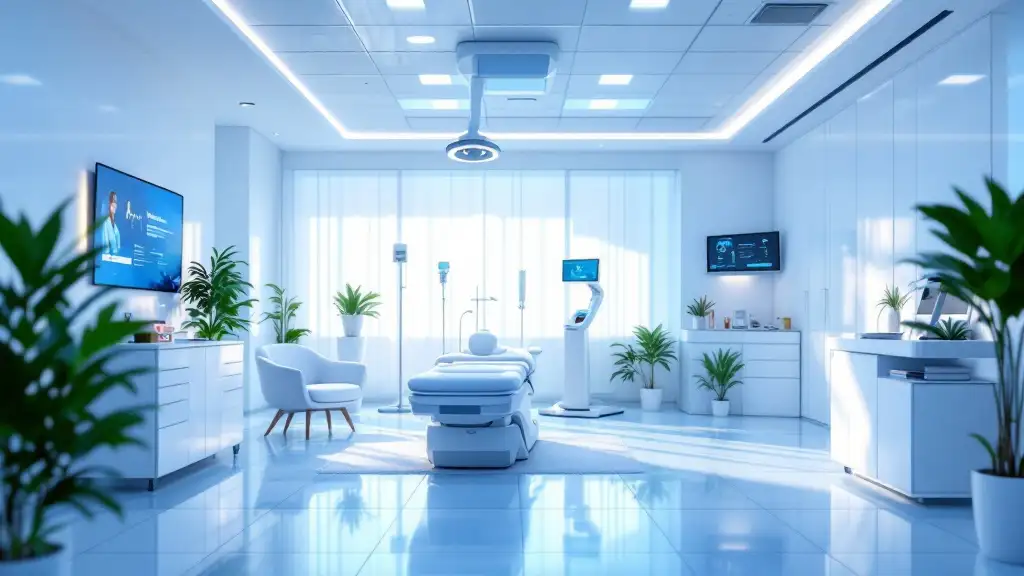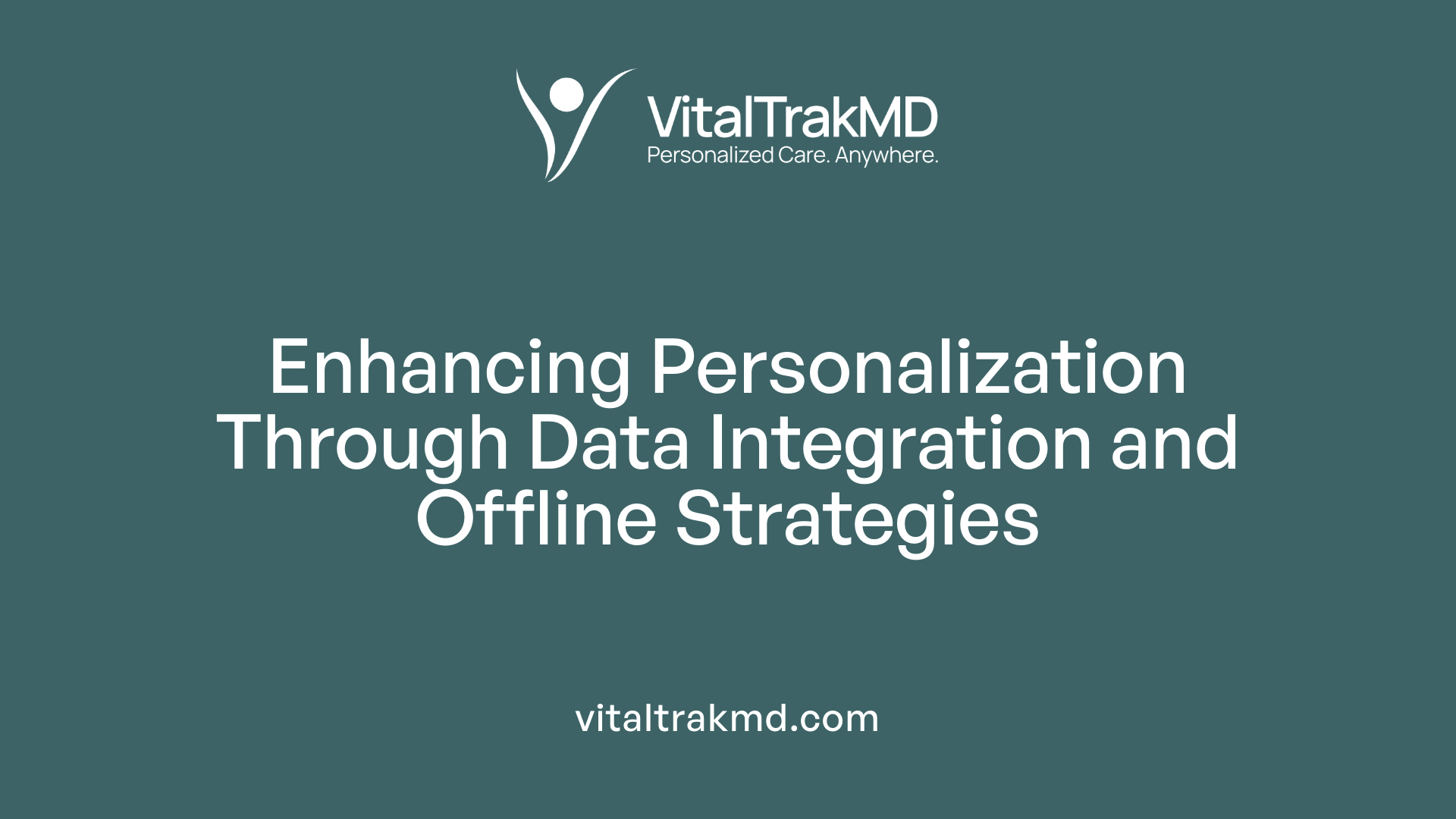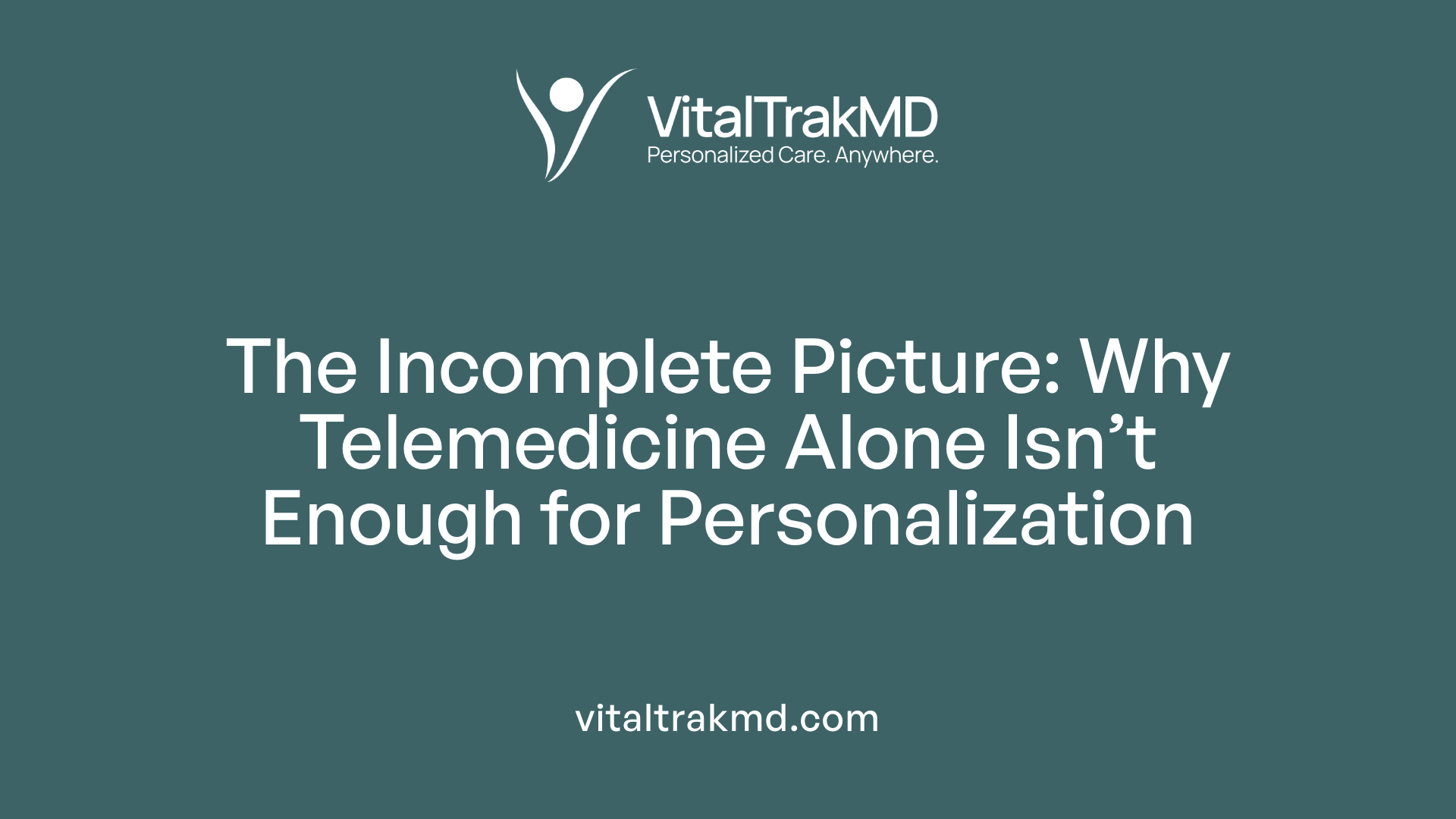Why Telemedicine Alone Isn’t Enough for Personalized Healthcare

Understanding the Scope and Boundaries of Telemedicine in Personalized Care
Telemedicine has revolutionized healthcare access by overcoming geographical barriers, reducing costs, and supporting remote patient management. However, despite these advances, telehealth alone falls short of delivering comprehensive, personalized healthcare. This article explores the multifaceted challenges, limitations, and necessary complementary strategies to create a truly patient-centered healthcare system.
The Core Benefits and Capabilities of Telehealth
Overcoming geographical barriers
Telehealth is transforming healthcare by removing distance barriers, making it possible for individuals in rural, frontier, or underserved areas to access medical services without the need for travel. This is particularly valuable in communities where healthcare facilities are scarce, thus expanding access and reducing health disparities.
Enhancing healthcare access and efficiency
By integrating telehealth with digital tools, secure communication, and data recording, providers can deliver timely care that is more personalized and efficient. Fully integrated platforms support rapid connections, streamlined messaging, and automatic data logging, making virtual visits more productive and reducing delays in care.
Supporting management of chronic conditions
Virtual care enables more frequent monitoring of chronic illnesses like hypertension, facilitating quicker treatment adjustments. Programs such as Kaiser Permanente’s hypertension control initiative demonstrate improved health outcomes through regular virtual check-ins, which improve disease management and patient adherence.
Reducing hospital admissions and readmissions
In long-term post-acute care, telehealth reduces hospital stays by providing essential services remotely, which helps prevent unnecessary admissions and readmissions. During the COVID-19 pandemic, remote monitoring programs have shown significant success in avoiding hospital bed occupancy, saving resources and improving patient safety.
Supporting provider training and increasing service capacity
Telehealth supports ongoing provider education and increases overall service capacity by enabling specialist consultations and continuous provider development. This extension of services improves care quality while alleviating pressures on brick-and-mortar healthcare facilities.
Cost savings and economic benefits
Studies, such as a 2014 analysis, suggest telehealth can save billions annually—$6 billion for US employers alone—by reducing unnecessary ER visits, hospital stays, and improving chronic disease management. These savings underscore telehealth’s role in making healthcare more affordable and sustainable.
Broader challenges of implementing effective personalized healthcare systems
Despite these advantages, establishing personalized healthcare systems faces several obstacles. Technological integration requires interoperable digital tools and analytics infrastructure, while safeguarding patient data privacy remains critical. Ethical considerations around equity and algorithm biases must be addressed to ensure fair treatment. Regulatory fragmentation complicates the approval process, and systemic challenges like high costs and resistant organizational culture hinder widespread adoption.
| Aspect | Challenges/Considerations | Additional Details |
|---|---|---|
| Technological Infrastructure | Need for interoperable systems and data standards | Ensures seamless data sharing and communication |
| Data Privacy & Security | Protecting sensitive health data | Critical for maintaining trust and compliance |
| Ethical & Equity Issues | Addressing bias and ensuring access | Prevents discrimination, promotes fairness |
| Regulatory Environment | Harmonizing laws and approval processes | Facilitates wider implementation |
| Resource Allocation | High costs and resistance to change | Overcoming these hurdles is essential for success |
As telehealth continues to evolve, overcoming these challenges will be vital to unlocking the full potential for personalized care, improved outcomes, and greater healthcare efficiency.
The Complementary Role of Data Integration and Offline Personalization
 Integrating telehealth with offline personalized care plans is essential for delivering truly tailored health services. While virtual visits and remote monitoring provide valuable convenience and access, combining these with customized intervention strategies and comprehensive data recording enhances patient engagement.
Integrating telehealth with offline personalized care plans is essential for delivering truly tailored health services. While virtual visits and remote monitoring provide valuable convenience and access, combining these with customized intervention strategies and comprehensive data recording enhances patient engagement.
A fully integrated telehealth system captures vital health data automatically during each interaction. Features such as automatic data logging, secure storage, and real-time updates allow providers to build detailed health profiles for each patient. This ongoing collection supports proactive, data-driven decision-making, enabling early intervention and personalized treatment adjustments.
Effective platforms incorporate various features to improve personalization. Device agnosticism ensures compatibility across smartphones, tablets, and computers, making access straightforward regardless of the patient’s technology preference. Unified messaging and configurable content allow healthcare teams to communicate seamlessly, deliver tailored advice, and reinforce care plans.
What is the role of integrated communication and health navigation solutions in personalized healthcare?
These solutions facilitate coordinated care across multiple providers and settings, ensuring that patient information flows smoothly between systems and team members. They help patients navigate complex healthcare systems by providing timely updates, reminders, and support, which reduces confusion and delays. Custom communication tools, such as secure texting, video calls, and visual aids, empower patients with disabilities or language barriers to participate actively in their care.
When combined with offline personalized plans, this technology fosters continuous, engaging, and responsive care experiences. Patients benefit from more meaningful interactions, better understanding of their health conditions, and increased adherence to treatment protocols. Ultimately, the integration fosters a more human and efficient healthcare environment, improving overall outcomes and satisfaction.
The Limitations of Telehealth as a Standalone Solution

What are the limitations of telemedicine as a standalone solution for personalized healthcare?
While telehealth presents many advantages in expanding healthcare access and efficiency, it has notable limitations when used alone. One primary challenge is its inability to perform comprehensive physical examinations. Without physical assessments, healthcare providers may miss crucial clinical signs, which can lead to misdiagnosis or delayed treatment adjustments.
Technical issues also pose significant risks. Poor internet connectivity and cybersecurity vulnerabilities threaten the accuracy and confidentiality of patient data. Such concerns can compromise both safety and trust, ultimately affecting the quality of care.
Regulatory and licensing barriers further complicate telehealth's use. Different states and countries have varying rules, which restrict providers from practicing across borders or offering certain services without local licensing. This fragmentation limits the continuity of care and can hinder rapid responses to patient needs.
Vulnerable populations—such as elderly individuals, low-income groups, and those with limited digital literacy—face additional hurdles. These groups often lack reliable internet access or the skills necessary to navigate telehealth platforms effectively, widening existing health disparities.
Certain clinical situations clearly require in-person evaluation, especially cases involving urgent intervention, complex physical exams, or procedures that cannot be safely or accurately conducted remotely. Such scenarios underscore the importance of integrating telehealth with traditional care methods.
In essence, while telehealth can significantly enhance healthcare delivery, its effectiveness is constrained when used in isolation. Comprehensive care models that combine virtual and in-person elements are essential to ensure quality, safety, and equitable access.
Why Telemedicine Alone Cannot Deliver Complete Personalized Healthcare

Why can't telemedicine alone provide comprehensive, personalized healthcare?
While telemedicine has transformed healthcare delivery by enhancing access, efficiency, and managing chronic conditions remotely, it falls short of offering the full spectrum of personalized care. One primary limitation is its inability to perform thorough physical examinations and immediate diagnostics. Certain conditions require hands-on assessments, palpation, or in-person testing, which telehealth cannot adequately replicate.
Moreover, reliance on patient self-reporting and technology-based data collection can introduce inaccuracies. These gaps may lead to misdiagnoses or delayed interventions, affecting care quality. For example, subtle physical cues or signs detectable only through in-person exams might be missed.
Technical issues also pose hurdles. Concerns about data privacy and security are significant, especially with the increasing use of digital tools. Regulatory and licensing obstacles can restrict cross-state or cross-country telehealth practices, limiting access and continuity of care.
Patient and provider perceptions influence telemedicine’s effectiveness. Variations in digital literacy and comfort with virtual interactions mean some populations might not engage fully or benefit equally. Particularly among older adults or underserved communities, lack of familiarity with technology can hinder access.
Certain clinical situations inherently demand physical presence. Emergencies, complex surgical assessments, and procedures require direct contact, physically interacting with the patient or operating specialized equipment.
Overall, despite its numerous advantages, telemedicine is best viewed as a supplement rather than a complete replacement for in-person, personalized healthcare. Full, nuanced patient care often necessitates physical interaction, advanced diagnostics, and the human touch that virtual platforms cannot fully emulate.
Gaps and Barriers Preventing Telemedicine from Realizing True Personalization

What are the gaps in telemedicine that prevent it from being sufficient for personalized healthcare?
While telehealth offers considerable benefits in expanding access and improving efficiency, several notable gaps hinder its ability to deliver fully personalized care. One significant issue is the limited capability for physical examinations. Unlike in-person visits, virtual consultations cannot easily include comprehensive physical assessments, which are often essential for accurate diagnosis and treatment adjustments.
Another challenge lies in data integration and interoperability. Many telehealth systems operate in silos with incompatible formats, making it difficult to compile patient information from various platforms. This fragmented data can impede healthcare providers from seeing the complete picture of a patient’s health, affecting the quality of personalized care.
Disparities in access further complicate efforts toward individualized treatment. Vulnerable populations—such as those living in rural areas, the elderly, or economically disadvantaged groups—often face barriers like limited internet connectivity, low digital literacy, and lack of appropriate devices. These issues create health inequities, preventing some patient groups from benefiting equally from telehealth innovations.
Privacy and security concerns also pose significant hurdles. Ensuring compliance with regulations like HIPAA, safeguarding patient data, and maintaining trust are ongoing challenges. Regulatory barriers, including licensing restrictions across state lines and variations in telehealth laws, can restrict service delivery and customization.
Furthermore, the costs associated with implementing advanced telehealth infrastructure can be prohibitive. High setup and maintenance expenses, coupled with infrastructural limitations, especially in underserved regions, restrict the widespread adoption of sophisticated, personalized telemedicine solutions.
In sum, the current limitations of telemedicine—ranging from physical assessment constraints and data fragmentation to disparities, security issues, and costs—prevent it from offering the fully personalized healthcare experience that patients deserve. Addressing these gaps requires ongoing technological, policy, and social efforts to make virtual care more comprehensive and equitable.
The Unique Challenges of Telehealth in Industries like Maritime Healthcare
Why can't telemedicine be solely relied upon in industries like maritime healthcare?
Telemedicine offers many advantages, such as overcoming geographical barriers and supporting remote monitoring, but it cannot address all healthcare needs in areas like maritime healthcare. Maritime environments often require urgent, hands-on medical interventions that only in-person or specialized care can provide. For example, in emergencies, physical examinations, complex procedures, and immediate life-saving interventions are essential, and these cannot be fully managed through virtual platforms.
Furthermore, technological infrastructure limitations pose significant challenges. Many maritime settings lack reliable internet access, making real-time video consultations and data sharing difficult. Vulnerable populations, such as crew members with limited digital literacy or older seafarers, may find telehealth platforms difficult to navigate, worsening health disparities.
Cultural, language, and sensory barriers also affect the effectiveness of telehealth in this context. Diverse crews from different regions may face communication issues, and sensory impairments like hearing or vision loss can hinder remote assessments.
Given these complexities, a comprehensive healthcare strategy that combines telemedicine with traditional, in-person care is vital. Such an integrated approach ensures that special medical needs are met, infrastructure challenges are addressed, and equitable access is promoted, especially in specialized and remote industries like maritime healthcare.
The Need for a Combined Approach with AI, Digital Solutions, and Telehealth
Why is a combined approach involving telehealth, AI, and digital solutions necessary for personalized healthcare?
Implementing a blend of telehealth, artificial intelligence (AI), and digital innovations is vital to advancing personalized healthcare. Each component plays a unique role in transforming patient care into a more tailored, efficient, and accessible system.
First, integrating these technologies allows for the collection and analysis of diverse data sources. For example, AI can process complex information from genomic profiles, clinical histories, social factors, and lifestyle habits. This comprehensive data collection helps providers deliver precise diagnoses and develop customized treatment plans.
AI acts as a powerful support tool by offering sophisticated data interpretation, predictive analytics, and clinical decision support. It enables healthcare providers to anticipate health risks, identify disease patterns early, and optimize treatment options, leading to better patient outcomes.
Telehealth dramatically expands access to healthcare. It supports ongoing patient engagement and monitoring, especially for those in rural or underserved areas. Patients can stay connected with healthcare teams, receive consistent follow-up, and manage chronic conditions remotely, all without geographic restrictions.
Digital solutions complement these efforts by facilitating real-time data collection, remote monitoring, and instant communication. This continuous flow of information makes interventions more timely and personalized, improving the overall quality of care.
The convergence of these technologies fosters a holistic, patient-centered approach that dynamically adapts to individual needs. It minimizes adverse effects, enhances therapeutic efficacy, and promotes active patient participation.
In summary, a combined approach leverages the strengths of telehealth, AI, and digital tools to create a healthcare ecosystem that is smarter, more accessible, and truly tailored to each person, ensuring better health outcomes and more personalized care.
Integrating Strategies for a Future of Truly Personalized Healthcare
While telemedicine offers substantial benefits in increasing access, supporting chronic disease management, and reducing healthcare costs, it is inherently limited in delivering the full scope of personalized care. To truly achieve tailored healthcare, a multifaceted strategy that combines telehealth with robust data integration, AI-driven analytics, comprehensive communication systems, and in-person care is essential. Addressing the technological, regulatory, and equity challenges will be critical for developing an inclusive, efficient, and effective healthcare system capable of meeting the nuanced needs of every patient. As healthcare continues evolving, embracing integrated, patient-centered approaches will be the key to closing existing gaps and unlocking the promise of personalized medicine.
References
- Why “Telehealth” Alone Isn't Enough | Mozzaz
- Improving Telehealth & Virtual Care Strategy | Blog
- The Telehealth Era Is Just Beginning
- Healthcare Myths for Clinicians: 4 Assumptions to Rethink
- The tragic paradoxical effect of telemedicine on healthcare ...
- The tragic paradoxical effect of telemedicine on healthcare ...
- The Benefits and Limitations of Telehealth
Recent articles
Want to Feel Better and Live Healthier?
Join hundreds of patients taking control of their health with personalized care that fits their life – not the other way around.
Rated 4.8/5 by 32+ customers







